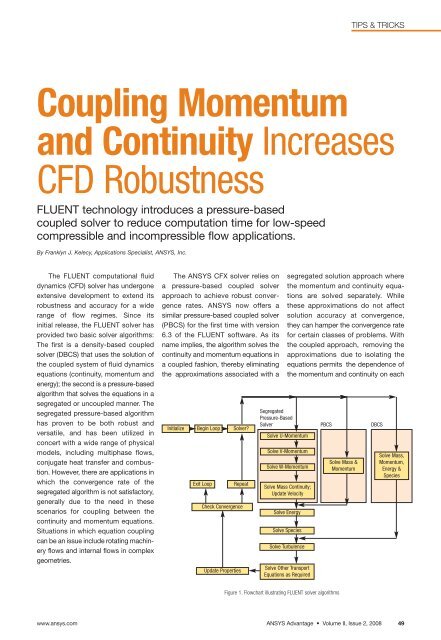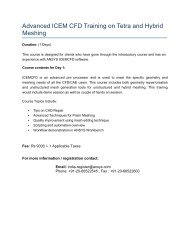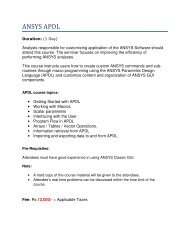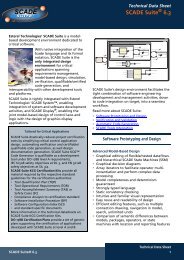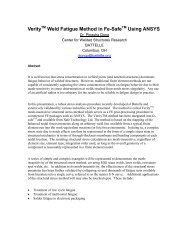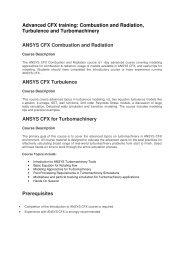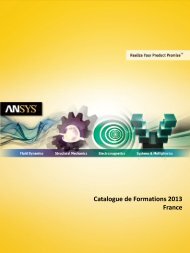Simulation - ANSYS
Simulation - ANSYS
Simulation - ANSYS
You also want an ePaper? Increase the reach of your titles
YUMPU automatically turns print PDFs into web optimized ePapers that Google loves.
Coupling Momentum<br />
and Continuity Increases<br />
CFD Robustness<br />
FLUENT technology introduces a pressure-based<br />
coupled solver to reduce computation time for low-speed<br />
compressible and incompressible flow applications.<br />
By Franklyn J. Kelecy, Applications Specialist, <strong>ANSYS</strong>, Inc.<br />
The FLUENT computational fluid<br />
dynamics (CFD) solver has undergone<br />
extensive development to extend its<br />
robustness and accuracy for a wide<br />
range of flow regimes. Since its<br />
initial release, the FLUENT solver has<br />
provided two basic solver algorithms:<br />
The first is a density-based coupled<br />
solver (DBCS) that uses the solution of<br />
the coupled system of fluid dynamics<br />
equations (continuity, momentum and<br />
energy); the second is a pressure-based<br />
algorithm that solves the equations in a<br />
segregated or uncoupled manner. The<br />
segregated pressure-based algorithm<br />
has proven to be both robust and<br />
versatile, and has been utilized in<br />
concert with a wide range of physical<br />
models, including multiphase flows,<br />
conjugate heat transfer and combustion.<br />
However, there are applications in<br />
which the convergence rate of the<br />
segregated algorithm is not satisfactory,<br />
generally due to the need in these<br />
scenarios for coupling between the<br />
continuity and momentum equations.<br />
Situations in which equation coupling<br />
can be an issue include rotating machinery<br />
flows and internal flows in complex<br />
geometries.<br />
The <strong>ANSYS</strong> CFX solver relies on<br />
a pressure-based coupled solver<br />
approach to achieve robust convergence<br />
rates. <strong>ANSYS</strong> now offers a<br />
similar pressure-based coupled solver<br />
(PBCS) for the first time with version<br />
6.3 of the FLUENT software. As its<br />
name implies, the algorithm solves the<br />
continuity and momentum equations in<br />
a coupled fashion, thereby eliminating<br />
the approximations associated with a<br />
Initialize<br />
Begin Loop Solver?<br />
Exit Loop<br />
Repeat<br />
Check Convergence<br />
Update Properties<br />
Segregated<br />
Pressure-Based<br />
Solver PBCS DBCS<br />
Solve U-Momentum<br />
Solve V-Momentum<br />
Solve W-Momentum<br />
Solve Mass Continuity;<br />
Update Velocity<br />
Solve Energy<br />
Solve Species<br />
Solve Turbulence<br />
Solve Other Transport<br />
Equations as Required<br />
Figure 1. Flowchart illustrating FLUENT solver algorithms<br />
segregated solution approach where<br />
the momentum and continuity equations<br />
are solved separately. While<br />
these approximations do not affect<br />
solution accuracy at convergence,<br />
they can hamper the convergence rate<br />
for certain classes of problems. With<br />
the coupled approach, removing the<br />
approximations due to isolating the<br />
equations permits the dependence of<br />
the momentum and continuity on each<br />
Solve Mass &<br />
Momentum<br />
TIPS & TRICKS<br />
Solve Mass,<br />
Momentum,<br />
Energy &<br />
Species<br />
www.ansys.com <strong>ANSYS</strong> Advantage • Volume II, Issue 2, 2008 49


